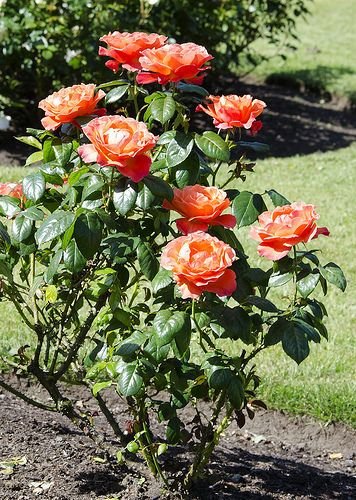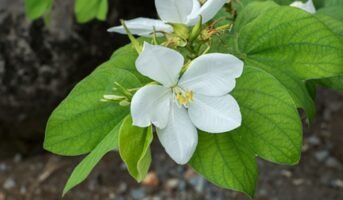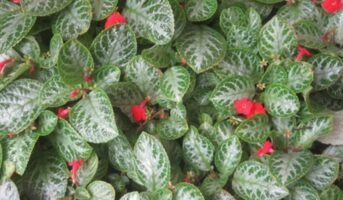Floribunda roses have the same beautiful appearance as hybrid tea blooms; however, they grow in clusters rather than with one flower on each stem. Floribundas combine hardiness, free flowering, and gorgeous, typically scented blooms. They are a hybrid of polyantha species roses and hybrid teas. These hardy roses come in a range of sizes, from low-growing and compact to 5–6 feet tall, which makes them perfect for tall hedges.
With their continual bloom cycles and resistance to disease, Floribunda roses are a low-maintenance shrub that has a big impression. The majority of Floribundas just need damaging or dead wood removed during their spring trimming.
Known about Button Rose
Floribunda rose: Quick facts

Source: Pinterest
| Biological name | Rosa |
| Plant type | Rose |
| Common name | Floribunda rose |
| Width | 0 to 6 feet |
| Height | 5 to 6 feet |
| Foliage colour | Gold/chartreuse |
| Seasonal compatibility | Summer bloom, spring bloom, fall bloom |
| Differentiating features | Low maintenance, fragrance, good for containers, cut flowers |
| Geographical zones | 4, 5, 6, 7, 8, 9 |
| Light needed | Full sun |
| Flower colour | White, pink, blue, red |
| Proliferation | Through stem cuttings |
| Problems it solves | Erosion and slope control, good for privacy |
| Soil needed | Fertile, well-drained soil with good moisture |
| Fragrance | Fragrance intensity ranges from strong to weak to nonexistent. |
| Resistance to disease | More resilient than hybrid teas, yet variable. |
| Tolerance to heat | Depending on the cultivar, variable. |
Types of Floribunda Rose
Amber Queen’ Rose

Source: Pinterest
The flowers of this shrub are apricot, yellow and pinkish in colour. Found in groups of 5 to 7, these flowers have a spicy fragrance. This type of Floribunda Rose is resistant to diseases and blooms continuously.
See also about: cocoa tree
Angel Face’ Rose

Source: Pinterest
These lavender roses are from a compact rose shrub and grows generously in full sunlight. These grow both in single stems and in groups. These roses have a sweet note when it comes to fragrance. One must take care of these types of Floribunda roses as they are prone to insect attacks.
Blueberry Hill’ Rose

Source: Pinterest
‘Blueberry Hill’ variety bears large semi-double rose flowers with over 15 petals. This rose plant has a fruity fragrance attached that is more apple in nature. These plants are resistant to pests and grow well.
Cinco de Mayo’ Rose

Source: Pinterest
These reddish orange roses grow in clusters and have petals over 25 to 30. They have a mild fragrance and blooms from spring to fall. These are disease resistant and have dark green glossy leaves.
French Lace’ Rose

Source: Pinterest
These ivory and apricot roses make up for a classic look. Classy looking these roses are small and disease resistant.
Hot cocoa Rose

Source: Pinterest
As the name suggests, these are hot chocolate colour rose plants that are disease resistant and grow easily.
Floribunda rose: Distinguishing features

Source: Pinterest
A stiff, bushy, upright shrub rose known as a Floribunda bears clusters of flowers continuously from summer to October (as opposed to hybrid teas, which typically produce flowers singly on each stem). While the flowers are smaller than those of hybrid teas, the magnificent floral display they create when they are present in huge clusters. Since their stems are shorter than those of hybrid tea roses, they are cultivated for display rather than for use as cut flowers. They are hardy and freely blossoming and produce stunning, fragrant blooms.
In order to create roses that bloom profusely like polyanthas but have the beauty and variety of colours of hybrid teas, they were crossed with polyantha roses to create Floribundas. Although less compact and widespread than your ordinary polyantha, they are smaller than a standard hybrid tea. Blooms are a wonderful addition to a rose bed, mixed border, or even a container on the patio because they have the traditional hybrid tea shape and are offered in the same spectacular spectrum of colours.
know about: small patches of ground for plants
Floribunda rose: How to grow?

Source: Pinterest
To grow a Floribunda rose, we will look at the various steps to implement the complete process of planting and growing this plant.
Step 1: Deciding when to plant
Although containerised roses can be planted anywhere at any time of the year, the most suitable time to do so is from the start of autumn to the beginning of spring because this is when they go dormant. If the soil is frozen or wet, do not plant a new Floribunda rose. Keep containerised plants in a heated outbuilding if the weather is unsuitable, and “heel in” rhizomes roses by creating a trench in regular garden soil, putting the roots inside, and filling it with loose dirt. If the weather is very abrasive, provide additional fleece protection.
Step 2: Choosing a site to plant
Floribunda roses prefer to grow in an area that is bright and protected from severe winds. If they are surrounded by other plants or in the shadow, they won’t thrive. They thrive best in well-drained soil because they normally do not tolerate moist ground. When planting, add some sand, coarse gravel, and organic matter to your garden if it naturally drains moist.
Step 3: Planting it
Before planting, double-dig the soil to prevent compaction and make sure it is well-aerated. Dig a hole deep enough that the graft will sit at soil level and broad enough to easily accommodate the roots (to spot the graft point, look for a bulge at the base of the shoots). Backfill the planting hole with a mixture of the dug soil and a lot of well-rotted organic materials, such as composted garden waste, recycled green waste, or manure. As roses were heavy feeders, we also advise adding a substantial portion of the rose feed. Water thoroughly and compact the dirt.
Step 4: Growing roses in containers
Roses do well in containers as well, so if you have clay-heavy soil or want to add some colour to your patio, that is a nice alternative. Pick a deep container to suit the deep tap root system of the rose plant. Select a compost with a loam basis, like John Innes No. 3, water it well, and top-dress your roses with fertiliser every April. Other than feeding your rose frequently with rose food or another high-potassium fertiliser throughout the summer flowering time, all other planting procedures are the same as when growing a rose in the soil.
Floribunda rose: How to maintain?

Source: Pinterest
To maintain a Floribunda rose plant well, you can essentially take care of the plant in the following aspects.
Regular pruning
Your order to obtain the accurate rose will grow quickly and bloom well every year if you prune it correctly. The limbs of your rose shrub may eventually tangle and begin to look messy if continually left unpruned. Early March, when they are just beginning to grow again, is the perfect time to prune Floribunda roses. Make absolutely sure you have the proper tools for the job, including a decent pair of garden gloves and a pair of sharp secateurs.
First, trim back any weak branches to the root if necessary to prevent overcrowding and achieve an open goblet form. Next, remove any crossed, dead, diseased, or damaged stems. The remaining stems should then be cut to within 25–30 cm (10–1 foot) of the ground. To maintain things neat and lower the danger of disease, remove any debris and fallen leaves from the area surrounding the plant’s base. Then, fertilise the plant with rose feed.
Light
The optimal conditions for Floribunda roses are full sun and light shade. Full sun, however, enhances their blooming and overall disease resistance.
Protection from cold
Since most Floribunda roses are not entirely hardy, they will need some frost protection during severe cold spells and frosts in the UK. The best material is horticultural fleece, but other permeable textiles also function well.
Watering
Due to their exceptional hardiness, Floribundas require less maintenance than other types. We advise you to water the plant just at the base rather than directly on the foliage, as this may promote leaf disease and scorch.
Soil
Particularly, these rose bushes prefer organically rich, somewhat acidic soil. Cover the plants to reduce water use and keep the roots cool.
Diseases and pests
Although no Floribunda rose is totally resistant to disease, we only take it into account when considering roses with an appropriate standard of disease resistance. Below, we list some of the most significant issues and provide solutions:
Dieback
Dieback is frequently brought on by a mixture of poor maintenance, bad weather, and pests/diseases. Since prevention is always preferable to treatment, plant your roses in soil that has been properly prepared and is not susceptible to drought or waterlogging. Also, distribute the roots, prune each year, feed with rose feed in the spring, and water for extended periods in dry weather. Make sure you follow all of the aforementioned instructions if your plant exhibits dieback, and you might also think about using a fungal killer sprayer if you think this may be a contributing factor.
Rose aphids
Insects like blackflies, greenflies, and others that will leech the sap off your rose bushes. Regularly look for signs of infection on the buds, under the leaves, and on the roses themselves. If the infection is small, squashing the bugs may be enough to get rid of them, but more often than not, an aphid insect killer spray is needed.
Blindness (not enough flowers)
While it is common for some stems not to bloom every year, a persistent lack of blooms throughout the majority of stems is definitely an indication of trouble. The energy of the plant is misdirected, not put into blossoms, which results in “blindness.” The most recurring cause is excessive exposure to inclement weather or excess shade, which may be remedied by offering some protection or cover and making sure your roses are grown in a sunny location. To promote healthy new shoots, make sure to remove all or the majority of the older wood throughout the annual pruning. You should also prune any blind branches by halving their length to a robust bud.
Black spot
Black or dark purple blotches on the leaves are a sign of a fungal disease, which frequently causes the leaves to turn yellow or drop off the plant. Utilising a fungus killer sprayer as soon as possible after gathering and destroying any afflicted falling leaves is the best strategy to combat black spots.
Fertiliser
Due to their intense feeding habits, Floribunda roses benefit from regular fertiliser applications. Pick a fertiliser with a balanced formula or one with a rose label. If the pH of the soil is high, iron is crucial. Use an iron supplement if the leaves start to turn yellow with greenish veins.
Floribunda rose: Uses and benefits
Floribundas are genuinely all-purpose roses due to their abundant, continuous flowering over very compact, dense-leaved plants, as well as their overall ease of maintenance. They are perfect for edging beds as well. They look lovely when planted in large quantities and are best grown in a group of three or more. These kinds of roses are often used to add to the overall aesthetic of gifting.
FAQs
How frequently do I need to fertilise my roses?
Roses should get fertiliser three times a year to promote brisk growth and profusion of bloom. Each time you fertilise a plant, scatter 1/4 cup of fertiliser around it. Fertilising later will result in succulent new growth that might not harden enough before winter.
What is the best place to plant Floribunda rose?
Floribunda roses prefer to grow in an area that is bright and protected from severe winds. If they are surrounded by other plants or in the shadow, they won't thrive. They thrive best in well-drained soil because they normally do not tolerate moist ground.
How can I control the black spots on my roses?
A typical fungus disease of roses is called black spot. Circular black patches on the leaves are blackspot symptoms. Severely diseased plants may be completely defoliated by late summer. Warm (75 degrees F), rainy weather is favourable for the formation of black spots.
What is the right way to deadhead roses?
On hybrid tea, as well as other repeat-flowering roses, deadheading is done to induce additional bloom. Mature roses can be pruned back to a leaf with five leaflets for deadheading. Use sharp instruments (a knife or pair of hand shears) to remove wilted flowers.
How often should I water my roses?
The optimum time to water roses is in the morning if overhead watering must be done. Most gardens only require a thorough watering every seven to ten days when the weather is dry. Mulching is a great strategy to keep soil moisture in check. Wood shavings, shredded bark, pine boughs and cocoa bean hulls are examples of potential mulches.
| Got any questions or point of view on our article? We would love to hear from you.
Write to our Editor-in-Chief Jhumur Ghosh at [email protected] |
Housing News Desk is the news desk of leading online real estate portal, Housing.com. Housing News Desk focuses on a variety of topics such as real estate laws, taxes, current news, property trends, home loans, rentals, décor, green homes, home improvement, etc. The main objective of the news desk, is to cover the real estate sector from the perspective of providing information that is useful to the end-user.
Facebook: https://www.facebook.com/housing.com/
Twitter: https://twitter.com/Housing
Email: [email protected]











